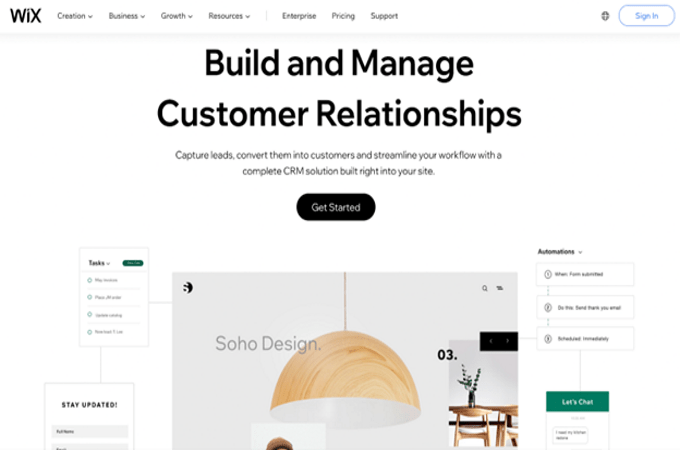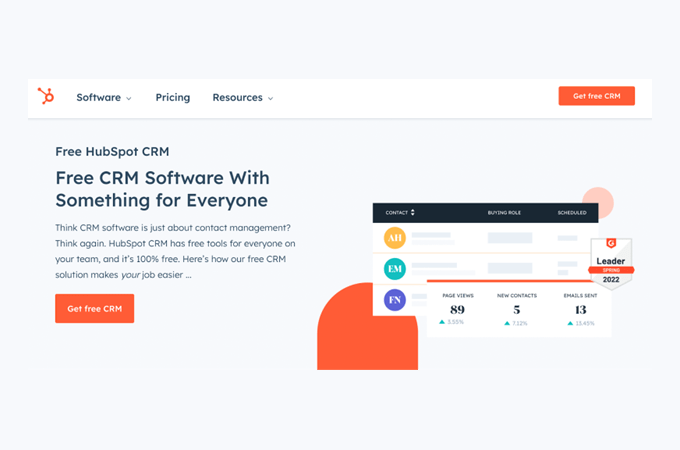CRM (customer relationship management) and CMS (content management systems) are two crucial software tools for managing businesses in the modern era. While the two terms are often confused with each other due to similar acronyms, they’re actually very different and serve two completely different purposes.
Once you understand the benefits and advantages of CRM and CMS, you can harness the power of each to scale your business and improve the customer experience. This guide will explain everything you need to know about CRM vs. CMS and how they work in unison when used correctly.
Top-Rated Content Management Systems (CMS)
Success with CMS starts with the right software. These are the best CMS platforms on the market today:
- WordPress – Best overall content management system
- Wix – Best website builder for content management
- Shopify – Best CMS for Ecommerce
- Squarespace – Best CMS for beautiful designs
- BigCommerce – Best CMS for high-volume ecommerce
- Joomla! – Best WordPress alternative
- Drupal – Best CMS for security
- Adobe Commerce (Formerly Magento) – Best CMS for advanced ecommerce Users
- Adobe Experience Management Sites – Best AI-powered CMS
- Magnolia CMS – Best omnichannel content hub
You can read our full reviews of each CMS software here.
Top-Rated Customer Relationship Management (CRM) Software
You’ll need a separate tool for customer relationship management, and this is the best place to start your search:
- HubSpot – Best for varying CRM needs
- Salesflare – Best for prospect management
- Zoho CRM – Best for a customizable CRM
- Freshsales – Best for managing sales leads
- Insightly – Best for project management features
- Apptivo – Best for adding services as you need them
- Pipedrive – Best for simplifying the sales process
- EngageBay – Best for automating customer service tasks
- Salesforce – Best for integrating multiple services
You can read our full reviews of the best CRM software here.
What are CRM and CMS?
CRM stands for “customer relationship management.” It’s software that’s used to track your leads, manage customer interactions, and store customer information. This makes it easy for sales and marketing teams to quickly understand every lead and customer journey from a single source of truth.
CMS stands for “content management system.” CMS software is used to manage and publish content on your website. From landing pages to blogs, SEO, plugins, and site analytics, everything can be handled through your CMS.
The Basics of CRM vs. CMS
Below we’ll take a closer look at the core elements of CRM vs. CMS, including differences and where the two overlap. This will give you a much better understanding of how they work.
Online Presence vs. Internal Information
CMS software is used to showcase your business or personal brand online. Anything published through your CMS can be viewed publicly by anyone who visits your website or searches for related information on a search engine.
Let’s say you want to publish a new blog or upload a video to your homepage. These actions can be handled through your CMS. In short, you need a CMS solution to have a website and online presence.
Your CRM software is an internal tool and can’t be accessed publicly by anyone outside of the organization. If a customer calls a sales rep to ask questions about a product, that interaction can be documented in the CRM system.
Without a CRM, you can’t provide your leads and customers with the best possible experience. Sales reps would have to rely on taking their own notes, and there isn’t any collaboration or sharing of information between team members.
Sales vs. Marketing
At a basic level, both CRM and CMS aid with sales and marketing. But at a granular level, each one favors a different department when you look at the finer details.
A CMS falls into the marketing category. Everything published on your CMS becomes the focal point of your brand from a marketing perspective.
It plays a significant role in your SEO strategy, so anyone who searches for keywords related to your brand can find your site in a search engine—even if they’ve never heard of you.
Your CMS landing pages will ultimately be where you’re directing traffic for any paid ad campaigns, social media marketing, affiliate marketing, and more. When you market your business online, you’re likely directing people to your website—which is powered by your CMS.
Conversely, CRM software is a sales tool. Once you get a customer’s information through a lead generation form, they’ll enter your CRM system.
Then your sales department can nurture that lead with a series of drip emails, calls, texts, or a combination of touchpoints. All of this depends on how your pipeline is structured.
Contact Management vs. Content Management
CRM is all about the customer. It’s about gathering as much information as possible for each user in your database and using that information to drive conversions.
Example contact management features in a CRM include:
- Contact name
- Contact information (phone, email, address, etc.)
- How the contact entered your funnel
- Date of first interaction
- Date of last interaction
- Sales history
- Deal tracking
As the name implies, a CMS is all about your content. It’s a single platform where you can create, edit, store, and publish your content online:
Some common CMS features that you should keep an eye out for include:
- Backend and frontend publishing tools
- Ability to store and organize digital assets
- Content editing tools
- Website themes
- Templates
- Blogging tools
- SEO tools
- Plugins and extensions
A good CMS platform is user-friendly and enables non-technical users to manage content without having to write code or understand complex programming languages.
Reporting and Analytics
Both CRM and CMS platforms are extremely useful for collecting information. You just need to generate the right reports and learn how to analyze that data.
When done correctly, you can use the reports to make data-driven decisions and improve your process.
For example, a good CRM tool can aggregate all of your sales data into a monthly or quarterly report. Then you can use this information to see which user segments are generating the most money, which sales reps are closing the most deals, identify your best customers, and so much more.
On the CMS side, you can track KPIs like site traffic, page views, bounce rates, and devices used to consume your content. You could use this information to determine which type of content is the most popular and use those insights for future content planning.
If your CMS doesn’t have built-in analytics, you can use third-party tools like Google Analytics to collect data and generate digestible reports.
3 Tools to Improve Customer Relationship Management and Content Management
Success with CRM and CMS all starts with the right software. Here are our top recommendations to get you started:
#1 — WordPress

If you’re starting a new website, WordPress is likely going to be your best option. WordPress dominates the global market share in this category, powering millions of websites worldwide—including Quicksprout.
The great part about using WordPress as a CMS is that it’s built to scale and completely customizable. Not only does it have everything you need to manage your content, but you can easily add functionality to your site by installing a plugin. This includes the ability to integrate your CRM and CMS with just a few clicks.
#2 — Wix

Wix is arguably the simplest website builder on the planet. You can build your entire website from scratch using drag-and-drop functionality or even use AI to build the site for you in just a few minutes. If you’re not running a content-heavy website and just want to keep it simple, Wix should be at the top of your list as you’re evaluating CMS platforms.
One unique standout of Wix compared to other tools in this category is that it also has a built-in CRM. So you won’t have to get a second tool for customer relationship management. If your pipeline is super basic and doesn’t require complex steps, then you can use Wix for all of your CMS and CRM needs.
#3 — HubSpot

HubSpot is one of the best and most popular CRM tools in existence. It comes with everything you need to manage your contact list and customer relationships at scale. You can use it to track your sales pipeline, monitor deals, and give your sales team the resources they need to succeed.
Best of all, Hubspot’s CRM is 100% free forever. It seamlessly integrates with all of the best CMS platforms, so you can quickly sync your data between platforms.
3 Pro Tips For Customer Relationship Management and Content Management
If you’re looking for a quick way to see immediate success with CRM and CMS solutions, the pro tips below will steer you in the right direction.
Pro Tip #1 — Integrate Your CRM and CMS
While CRM and CMS are two independent solutions used for different purposes, it doesn’t mean they can’t be used jointly. The easiest way to get the most out of your software is through integration.
If you’re a beginner, this might sound a bit intimidating. But it’s actually really easy.
All of the best CRM and CMS platforms play nicely with each other. You can typically find an integration in the form of a plugin or extension directly through your CMS. For example, you can browse through WordPress plugins to find your CRM and install it directly on your site.
Then you’ll just follow the authentication steps, and the two platforms can sync with ease. There’s no need to hire a developer or anything like that to do this. It’s just a matter of navigating to the plugin or extension marketplace and finding your CRM.
Now when someone lands on your side and fills out a lead generation form, they’ll automatically be sent to your CRM platform.
For those of you selling products or services online, integration with your CRM and CMS is the best way to add customer sales data to your CRM. Otherwise, you’d be forced to bounce back and forth between multiple platforms to see a customer’s purchase history. But it’s much easier when all of this information is presented through a single screen.
Pro Tip #2 — Use Automation to Your Advantage
In the early stages of using a CRM and CMS platform, you might think it’s easy to handle certain tasks manually. But at scale, these actions aren’t very practical or realistic.
I strongly suggest automating as much as possible on each of these platforms. This will make your life easier and save you hundreds, if not thousands, of hours over time.
For example, every time a new blog post gets published on your CMS platform, you can set it up to automatically share that post on Facebook, Twitter, or LinkedIn. This is much easier than having to manually post it on each platform.
Individually emailing each customer in your CRM platform might seem reasonable when you’re just starting out and only have a few dozen contacts. But what happens when you get 500, 1,000, or 5,000 contacts? All of a sudden it becomes impossible.
That’s why you should take advantage of automated drip campaigns in your CRM. Certain actions trigger a different sequence of messages.
For example, let’s say someone makes a purchase through your ecommerce store. A basic drip would be an order confirmation, delivery confirmation, follow-up for a review, and maybe a recommendation of similar products in a few weeks.
This drip would look very different from someone who just gave you their email address for the first time, and hasn’t made a purchase yet. You could drip this type of customer with different promotions, enticing them to buy something.
Pro Tip #3 — Simplify Your Tech Stack
Some all-in-one website builders come with a built-in CRM in addition to your CMS. But in the vast majority of cases, you’re going to need two different tools for each.
Don’t overcomplicate things. Find one great CRM and one great CMS.
It gets tough to manage when you’re using one tool to manage your website, another to publish content, a third tool for contact management, fourth for email marketing, fifth for pipeline management, sixth for lead generation, and so on.
There are so many great CRMs and CMS solutions on the market that you should be able to get everything you need from just two tools. Anything beyond that is just going to be a hassle for you in the long run.
What to Do Next
Now that you understand the core components and key differences between CRM vs. CMS, it’s time for you to get started on your own. The first thing you need to do is equip yourself with the right tools. Use our reviews of the best CRM software and our reviews of the best CMS systems to find the right ones for you.
From there, use the pro tips in this guide to integrate your tools and set them each up for automation. This ensures that your CRM and CMS are both well-oiled machines and ready to scale.
from Quick Sprout https://ift.tt/SpQM7lx
via IFTTT
No comments:
Post a Comment